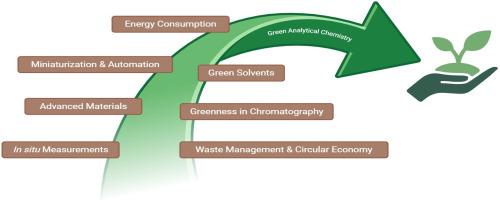Paving the way towards green contaminant analysis: Strategies and considerations for sustainable analytical chemistry
IF 6.2
引用次数: 0
Abstract
Contaminant analysis is essential for protecting environmental integrity, ensuring food safety, and safeguarding public health. However, traditional analytical methodologies, while robust and precise, often rely on resource-intensive practices that pose significant environmental challenges. This review delves into strategies for transitioning towards greener contaminant analysis, focusing on the integration of sustainable practices without compromising analytical performance. It discusses the application of green chemistry principles and white analytical methods, emphasizing their role in addressing the growing need for eco-friendly approaches in analytical chemistry. Key strategies for greener contaminant analysis are explored in depth, including: (1) in situ measurements, (2) green solvents, (3) miniaturization and automation, (4) advanced materials, (5) greenness in chromatography, (6) energy consumption, and (7) waste management and circular economy. Additionally, recent case studies are highlighted to showcase the practical implementation of these strategies in real-world scenarios. As the emergence and study of contaminants continue to gain prominence in analytical chemistry, the shift towards more sustainable analytical techniques becomes increasingly critical. This review aims to provide a comprehensive overview of the current trends, strategies, and future perspectives driving the development of greener methodologies in contaminant analysis.

为绿色污染物分析铺平道路:可持续分析化学的策略和考虑
污染物分析对于保护环境完整性、确保食品安全和保障公众健康至关重要。然而,传统的分析方法虽然强大而精确,但往往依赖于资源密集型的做法,这对环境构成了重大挑战。这篇综述深入研究了向绿色污染物分析过渡的战略,重点是在不影响分析性能的情况下整合可持续实践。它讨论了绿色化学原理和白色分析方法的应用,强调了它们在解决分析化学中对生态友好方法日益增长的需求中的作用。深入探讨了绿色污染物分析的关键策略,包括:(1)原位测量,(2)绿色溶剂,(3)小型化和自动化,(4)先进材料,(5)色谱绿色,(6)能源消耗,以及(7)废物管理和循环经济。此外,还强调了最近的案例研究,以展示这些策略在真实场景中的实际实现。随着污染物的出现和研究继续在分析化学中获得突出地位,向更可持续的分析技术的转变变得越来越关键。这篇综述的目的是提供一个全面的概述,当前的趋势,战略和未来的前景,推动绿色方法的发展,在污染物分析。
本文章由计算机程序翻译,如有差异,请以英文原文为准。
求助全文
约1分钟内获得全文
求助全文

 求助内容:
求助内容: 应助结果提醒方式:
应助结果提醒方式:


